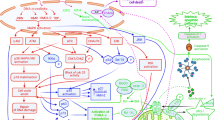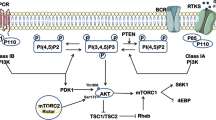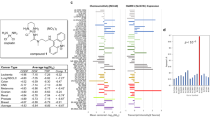Abstract
Multidrug resistance may be achieved by the activation of membrane transporters, detoxification, alterations in DNA repair or failure in apoptotic pathways. Recent data have suggested an involvement of mitogenic signalling pathways mediated by Ras and phosphoinositol-3-kinase (PI3K/Akt) in controlling multidrug resistance. Since these pathways are important targets for therapeutic interference, we sought to investigate whether blocking effectors kinases by specific inhibitors would result in a sensitization toward cytotoxic drugs. We found that cotreatment of drug-resistant HT29RDB colon cancer cells with the topoisomerase inhibitor doxorubicin and the PI3K-inhibitor LY294002 resulted in massive apoptosis, while cotreatment with the Mek inhibitors PD98059 or U0126 had no effect. This suggested that the PI3K-pathways controls cell survival and drug resistance in these cells. Besides blocking Akt phosphorylation, the PI3K-inibitor increased the intracellular doxorubicin concentration threefold. LY294002 inhibits drug export in a competitive manner as revealed by measuring drug efflux in the presence and the absence of inhibitor. The efficacy of drug efflux inhibition by LY294002 was similar to that achieved by the MRP1 inhibitors MK571 and genistein. We conclude that the PI3K inhibitor LY294002 may have therapeutic potential when combined with doxorubicin in the treatment of MRP1-mediated drug resistance.
This is a preview of subscription content, access via your institution
Access options
Subscribe to this journal
Receive 50 print issues and online access
$259.00 per year
only $5.18 per issue
Buy this article
- Purchase on Springer Link
- Instant access to full article PDF
Prices may be subject to local taxes which are calculated during checkout





Similar content being viewed by others
References
Agullo G, Gamet-Payrastre L, Manenti S, Viala C, Remesy C, Chap H et al. (1997). Biochem Pharmacol 53: 1649–1657.
Bates SE, Robey R, Miyake K, Rao K, Ross DD, Litman T . (2001). J Bioenerg Biomembr 33: 503–511.
Berg J, Tymoczko J, Stryer L . (2002). Biochemistry: Enyzmes, Basic Concepts and Kinetics, 5th edn. W.H. Freeman and Company: San Francisco.
Bos JL . (1989). Cancer Res 49: 4682–4689.
Brognard J, Clark AS, Ni Y, Dennis PA . (2001). Cancer Res 61: 3986–3997.
Burt RK, Garfield S, Johnson K, Thorgeirsson SS . (1988). Carcinogenesis 9: 2329–2332.
Chang F, Steelman LS, Shelton JG, Lee JT, Navolanic PM, Blalock WL et al. (2003). Int J Oncol 22: 469–480.
Chen TR, Drabkowski D, Hay RJ, Macy M, Peterson W . (1987). Cancer Genet Cytogenet 27: 125–134.
Chen Y, Sanchez Y . (2004). DNA Repair 3: 1025–1032.
Chen Z, Xiao Z, Chen J, Ng SC, Sowin T, Sham H et al. (2003). Mol Cancer Ther 2: 543–548.
Chin KV, Ueda K, Pastan I, Gottesman MM . (1992). Science 255: 459–462.
Clark AS, West K, Streicher S, Dennis PA . (2002). Mol Cancer Ther 1: 707–717.
Ding S, Chamberlain M, McLaren A, Goh L, Duncan I, Wolf CR . (2001). Br J Cancer 85: 1175–1184.
Di Simone D, Galimberti S, Basolo F, Ciardiello F, Petrini M, Scheper RJ . (1997). Anticancer Res 17: 3587–3592.
Filipeanu CM, Nelemans A, Veldman RJ, de Zeeuw D, Kok JW . (2000). FEBS Lett 474: 107–110.
Gekeler V, Ise W, Sanders KH, Ulrich WR, Beck J . (1995). Biochem Biophys Res Commun 208: 345–352.
Gewirtz DA . (1999). Biochem Pharmacol 57: 727–741.
Gottesman MM . (2002). Annu Rev Med 53: 615–627.
Gottesman MM, Fojo T, Bates SE . (2002). Nat Rev Cancer 2: 48–58.
Guise S, Braguer D, Carles G, Delacourte A, Briand C . (2001). J Neurosci Res 63: 257–267.
Györffy B, Serra V, Jürchott K, Abdul-Ghani R, Garber M, Stein U et al. (2005). Oncogene, Epub ahead of print.
Han JW, Dionne CA, Kedersha NL, Goldmacher VS . (1997). Cancer Res 57: 176–182.
Hu L, Hofmann J, Lu Y, Mills GB, Jaffe RB . (2002). Cancer Res 62: 1087–1092.
Jin W, Wu L, Liang K, Liu B, Lu Y, Fan Z . (2003). Br J Cancer 89: 185–191.
Kaushal GP, Kaushal V, Hong X, Shah SV . (2001). Kidney Int 60: 1726–1736.
Kim R . (2005). Cancer 103: 1551–1560.
Knuefermann C, Lu Y, Liu B, Jin W, Liang K, Wu L et al. (2003). Oncogene 22: 3205–3212.
Kok JW, Veldman RJ, Klappe K, Koning H, Filipeanu CM, Muller M . (2000). Int J Cancer 87: 172–178.
Kopnin BP, Stromskaya TP, Kondratov RV, Ossovskaya VS, Pugacheva EN, Rybalkina EY et al. (1995). Oncol Res 7: 299–306.
Krasilnikov MA . (2000). Biochemistry 65: 59–67.
Lee JT, Steelman LS, McCubrey JA . (2004). Cancer Res 64: 8397–8404.
Liu XM, Wang LG, Kreis W, Budman DR, Adams LM . (2001). Br J Cancer 85: 1403–1411.
Mizutani H, Tada-Oikawa S, Hiraku Y, Kojima M, Kawanishi S . (2005). Life Sci 76: 1439–1453.
Nakashio A, Fujita N, Rokudai S, Sato S, Tsuruo T . (2000). Cancer Res 60: 5303–5309.
Nakashio A, Fujita N, Tsuruo T . (2002). Int J Cancer 98: 36–41.
Ng SS, Tsao MS, Chow S, Hedley DW . (2000). Cancer Res 60: 5451–5455.
Plasschaert SL, van der Kolk DM, de Bont ES, Kamps WA, Morisaki K, Bates SE et al. (2003). Clin Cancer Res 9: 5171–5177.
Rodenhuis S . (1992). Semin Cancer Biol 3: 241–247.
Roehm NW, Rodgers GH, Hatfield SM, Glasebrook AL . (1991). J Immunol Methods 142: 257–265.
Skehan P, Storeng R, Scudiero D, Monks A, McMahon J, Vistica D et al. (1990). J Natl Cancer Inst 82: 1107–1112.
Sklar MD . (1988). Science 239: 645–647.
Srivastava AK . (1985). Biochem Biophys Res Commun 131: 1–5.
Stavrovskaya AA . (2000). Biochemistry 65: 95–106.
Vanhaesebroeck B, Stein RC, Waterfield MD . (1996). Cancer Surv 27: 249–270.
van Zanden JJ, Geraets L, Wortelboer HM, van Bladeren PJ, Rietjens IM, Cnubben NH . (2004). Biochem Pharmacol 67: 1607–1617.
van Zuylen L, Nooter K, Sparreboom A, Verweij J . (2000). Invest New Drugs 18: 205–220.
Vlahos CJ, Matter WF, Hui KY, Brown RF . (1994). J Biol Chem 269: 5241–5248.
Walker EH, Pacold ME, Perisic O, Stephens L, Hawkins PT, Wymann MP et al. (2000). Mol Cell 6: 909–919.
Wang Q, Li N, Wang X, Kim MM, Evers BM . (2002). Clin Cancer Res 8: 1940–1947.
Wang X, Martindale JL, Holbrook NJ . (2000). J Biol Chem 275: 39435–39443.
Xiao Z, Chen Z, Gunasekera AH, Sowin TJ, Rosenberg SH, Fesik S et al. (2003). J Biol Chem 278: 21767–21773.
Yu D, Liu B, Tan M, Li J, Wang SS, Hung MC . (1996). Oncogene 13: 1359–1365.
Zhao Y, You H, Yang Y, Wei L, Zhang X, Yao L et al. (2004). J Cell Biochem 91: 621–632.
Zuber J, Tchernitsa O, Hinzmann B, Schmitz AC, Grips M, Hellriegel M et al. (2000). Nat Genet 24: 144–152.
Acknowledgements
This work was supported by the Marie Curie fellowship (HPMD-CT-2000-00001).We thank Alexandra Stege and Conny Gieseler for technical help.
Author information
Authors and Affiliations
Corresponding author
Rights and permissions
About this article
Cite this article
Abdul-Ghani, R., Serra, V., Györffy, B. et al. The PI3K inhibitor LY294002 blocks drug export from resistant colon carcinoma cells overexpressing MRP1. Oncogene 25, 1743–1752 (2006). https://doi.org/10.1038/sj.onc.1209201
Received:
Revised:
Accepted:
Published:
Issue Date:
DOI: https://doi.org/10.1038/sj.onc.1209201
Keywords
This article is cited by
-
Cordycepin augments the chemosensitivity of osteosarcoma to cisplatin by activating AMPK and suppressing the AKT signaling pathway
Cancer Cell International (2021)
-
PI3K/AKT pathway as a key link modulates the multidrug resistance of cancers
Cell Death & Disease (2020)
-
Preconditioned adipose-derived stem cells ameliorate cardiac fibrosis by regulating macrophage polarization in infarcted rat hearts through the PI3K/STAT3 pathway
Laboratory Investigation (2019)
-
Thyroid hormones act as mitogenic and pro survival factors in rat ovarian follicles
Journal of Endocrinological Investigation (2019)
-
ASIC1a mediates the drug resistance of human hepatocellular carcinoma via the Ca2+/PI3-kinase/AKT signaling pathway
Laboratory Investigation (2017)



